My diffuse lighting doesn't seem to be working properly.
Fragment Shader:
#version 330 core
out vec4 gl_FragColor;
in vec4 vertexColor;
in vec2 texelCoord;
in vec3 Normal;
struct DirectionalLight
{
vec3 color;
float ambientIntensity;
vec3 direction;
float diffuseIntensity;
};
uniform sampler2D textureSampler;
uniform DirectionalLight directionalLight;
void main()
{
vec4 ambientColor = vec4(directionalLight.color, 1.0f) * directionalLight.ambientIntensity;
float diffuseFactor = max(dot(normalize(Normal), normalize(directionalLight.direction)), 0.0f);
vec4 diffuseColor = vec4(directionalLight.color, 1.0f) * directionalLight.diffuseIntensity * diffuseFactor;
gl_FragColor = texture(textureSampler, texelCoord) * (ambientColor + diffuseColor);
}
Vertex Shader:
#version 330 core
layout (location = 0) in vec3 position;
layout (location = 1) in vec2 texCoord;
layout (location = 2) in vec3 normal;
out vec4 vertexColor;
out vec2 texelCoord;
out vec3 Normal;
uniform mat4 transformation;
uniform mat4 projection;
uniform mat4 view;
void main()
{
gl_Position = projection * view * transformation * vec4( position, 1.0f );
vertexColor = vec4(clamp(position, 0.0f, 1.0f), 1.0f);
texelCoord = texCoord;
Normal = mat3(transpose(inverse(transformation))) * normal;
}
How I create Meshes:
void CalcAverageNormals( unsigned int* indices , unsigned int indicesCount , float* vertices , unsigned int verticesCount , unsigned int vertexLength , unsigned int normalOffset )
{
for ( int i = 0; i < indicesCount; i += 3 )
{
unsigned int v1 = indices[i] * vertexLength;
unsigned int v2 = indices[ i + 1 ] * vertexLength;
unsigned int v3 = indices[ i + 2 ] * vertexLength;
glm::vec3 line1( vertices[ v2 ] - vertices[ v1 ] , vertices[ v2 + 1 ] - vertices[ v1 + 1 ] , vertices[ v2 + 2 ] - vertices[ v1 + 2 ] );
glm::vec3 line2( vertices[ v3 ] - vertices[ v1 ] , vertices[ v3 + 1 ] - vertices[ v1 + 1 ] , vertices[ v3 + 2 ] - vertices[ v1 + 2 ] );
glm::vec3 normal = glm::normalize( glm::cross( line1 , line2 ) );
v1 += normalOffset;
v2 += normalOffset;
v3 += normalOffset;
vertices[ v1 ] += normal.x; vertices[ v1 + 1 ] += normal.y; vertices[ v1 + 2 ] += normal.z;
vertices[ v2 ] += normal.x; vertices[ v2 + 1 ] += normal.y; vertices[ v2 + 2 ] += normal.z;
vertices[ v3 ] += normal.x; vertices[ v3 + 1 ] += normal.y; vertices[ v3 + 2 ] += normal.z;
}
for ( int j = 0; j < verticesCount / vertexLength; j++ )
{
unsigned int offset = j * vertexLength + normalOffset;
glm::vec3 normalVertex( vertices[ offset ] , vertices[ offset + 1 ] , vertices[ offset + 2 ] );
normalVertex = glm::normalize( normalVertex );
vertices[ offset ] = normalVertex.x;
vertices[ offset + 1 ] = normalVertex.y;
vertices[ offset + 2 ] = normalVertex.z;
}
}
void CreateTriangle() {
float vertices[] {
-0.5f,-0.5f, 0.0f, 0.0f, 0.0f, 0.0f, 0.0f, 0.0f, // Left
0.5f,-0.5f, 0.0f, 1.0f, 0.0f, 0.0f, 0.0f, 0.0f, // Right
0.0f, 0.5f, 0.0f, 0.5f, 1.0f, 0.0f, 0.0f, 0.0f, // Top
0.0f,-0.5f, 0.5f, 0.5f, 0.0f, 0.0f, 0.0f, 0.0f // Back Z
};
unsigned int indices[]{
0, 1, 2, // Front
3, 2, 1, // Right
3, 2, 0, // Left
3, 0, 1 // Bottom
};
CalcAverageNormals( indices , 12 , vertices , 32 , 8 , 5 );
for ( int i = 0; i < 1; i++ )
{
Mesh* obj = new Mesh();
obj->CreateMesh( vertices , 32 , indices , 12 );
meshlist.push_back( obj );
}
}
CreateMesh()
void Mesh::CreateMesh( float* vertices , unsigned int numVertices , unsigned int* indices , unsigned int numIndices )
{
uIndices = numIndices;
glGenVertexArrays( 1 , &vao );
glBindVertexArray( vao );
/*Create Buffers*/
glGenBuffers( 1 , &ibo );
glBindBuffer( GL_ELEMENT_ARRAY_BUFFER , ibo );
glBufferData( GL_ELEMENT_ARRAY_BUFFER , numIndices * sizeof(unsigned) , indices , GL_STATIC_DRAW );
glGenBuffers( 1 , &vbo );
glBindBuffer( GL_ARRAY_BUFFER , vbo );
glBufferData( GL_ARRAY_BUFFER , numVertices * sizeof(float) , vertices , GL_STATIC_DRAW );
glVertexAttribPointer( 0 , 3 , GL_FLOAT , GL_FALSE , sizeof( vertices[ 0 ] ) * 8 , 0 );
glEnableVertexAttribArray( 0 );
glVertexAttribPointer( 1 , 2 , GL_FLOAT , GL_FALSE , sizeof( vertices[ 0 ] ) * 8 , ( void* )( sizeof( vertices[ 0 ] ) * 3 ) );
glEnableVertexAttribArray( 1 );
glVertexAttribPointer( 2 , 3 , GL_FLOAT , GL_FALSE , sizeof( vertices[ 0 ] ) * 8 , ( void* )( sizeof( vertices[ 0 ] ) * 5 ) );
glEnableVertexAttribArray( 2 );
/*Unbind Objects*/
glBindBuffer( GL_ARRAY_BUFFER , 0 );
glBindVertexArray( 0 );
glBindBuffer( GL_ELEMENT_ARRAY_BUFFER , 0 );
}
I only get some sort of lighting if I rotate the mesh:

Normal ( No lighting):

I been trying to figure this out for a days but I am not sure what I did wrong. If you could help me that would be great.